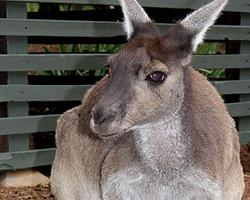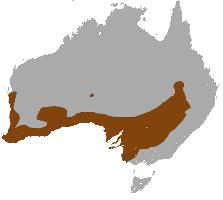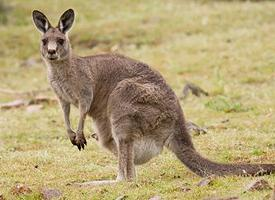
Poids et mesures
| Longueur | de 0,9 à 1,4 m |
|---|---|
| Poids | de 15 à 54 kg |
| Longueur de la queue | de 75 à 100 cm |
Statut de conservation
| Intrépide |
Description de l'animal
The Western grey kangaroo (Macropus fuliginosus) is a captivating and significant marsupial native to Australia, playing a crucial role in the biodiversity of its ecosystem. This species, belonging to the family Macropodidae, which includes kangaroos, wallabies, and their relatives, showcases a blend of remarkable physical attributes and intriguing behavioral patterns that have adapted over millennia to the diverse Australian landscapes.Characteristically, the Western grey kangaroo exhibits a robust and muscular build, with a heavy, thick tail that serves not only for balance while hopping at high speeds but also as a supportive tripod when standing upright. Their powerful hind legs are not just for locomotion; they are also formidable tools for defense, capable of delivering forceful kicks to potential predators. The fur of the Western grey kangaroo ranges in color from light grey to brown, with a noticeably lighter underbelly, a trait that aids in camouflage within their natural habitat.
Adult males, often referred to as "boomers," can reach a height of up to 2 meters (6.6 feet) and weigh around 90 kilograms (198 pounds), making them the second largest marsupial, following closely behind the red kangaroo. Females, on the other hand, are considerably smaller, a dimorphism that is common among kangaroo species. This size difference plays a significant role in their social structure and mating behaviors.
The Western grey kangaroo is predominantly a grazing animal, with a diet that consists mainly of grasses and small shrubs. Its digestive system has evolved to efficiently process this fibrous diet, much like that of other ruminants, though kangaroos do not regurgitate their food. This dietary preference means they are often found in open woodlands, grasslands, and areas where water sources are accessible, as hydration is crucial for their survival.
One of the most fascinating aspects of the Western grey kangaroo's biology is its reproductive system. Females possess the remarkable ability to delay the development of their embryo until environmental conditions are favorable, a phenomenon known as embryonic diapause. This ensures that the joey (baby kangaroo) is born at a time when survival chances are highest. After birth, the joey continues to develop in the safety of its mother's pouch for several months before venturing into the outside world.
Socially, Western grey kangaroos are known to form mobs or groups, a behavior that provides protection against predators and allows for the sharing of resources. These groups are typically matriarchal, with females and their young forming the core, and are led by the dominant male, whose role is to protect the group and mate with the females.
Despite their adaptability and widespread presence, Western grey kangaroos face threats from habitat loss due to agricultural expansion, vehicle collisions, and culling. Conservation efforts are in place to ensure their survival, emphasizing the importance of this species not only to Australia's natural heritage but also to the ecological balance within their habitats.
In summary, the Western grey kangaroo is a remarkable emblem of Australia's unique wildlife, showcasing a blend of physical prowess, social complexity, and ecological significance. Its continued presence in the Australian landscape underscores the need for ongoing conservation efforts to protect these iconic marsupials and their habitat for future generations.
Carte de répartition

Animaux similaires
Nouvelles photos d'animaux
Top 10 des animaux
- Dolphin gull (Leucophaeus scoresbii)
- Diana monkey (Cercopithecus diana)
- Moustached guenon (Cercopithecus cephus)
- Galápagos tortoise (Geochelone nigra complex)
- Russian tortoise (Testudo horsfieldii)
- Stone loach (Barbatula barbatula)
- Japanese macaque (Macaca fuscata)
- Greek tortoise (Testudo graeca)
- Common flying dragon (Draco volans)
- Vendace (Coregonus albula)


